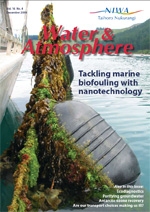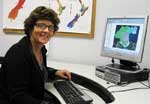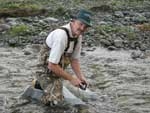PDF of this article (82 KB)


New Zealand Science, Mathematics and Technology Teacher Fellows
Carolyn Leersnyder: ‘Adaptation to climate change in a coastal community’
She will always remember 2008 as the year she moved out of the classroom and into the world of a NIWA scientist. With over 20 years experience teaching high school maths, Carolyn Leersnyder found her year as an NZSMT Teacher Fellow added meaningful context to the topics she teaches, vastly improved her scientific and technological knowledge, and gave her a much wider understanding of other curricula.
Carolyn’s project focused on the coastal community of Whitianga. She researched past storm events in order to understand current coastal hazards, and analysed coastal surveys to gain an appreciation of what is valued by local communities. Her visit to Whitianga’s Mercury Bay Area School highlighted the importance of community consultation and the educational opportunities relating to this project. Teachers at the school raised questions like “What does NIWA stand for?”, “Do we know how much sea level will rise by?”, and “How can our students get involved?”
As part of her studies, Carolyn attended a GIS (Geographical Information Systems) course, coming away with an understanding of the power of this technology and a tool for spatially analysing Whitianga census data. Carolyn now has a far greater understanding of this community’s vulnerability to coastal hazards and climate change.
Talking to scientists about the role of statistics in their projects has been a highlight of the year. Carolyn has enjoyed extracting the stories from the data and sharing these with colleagues at conferences and students in schools. Feedback from students demonstrates the importance of bringing the real world into the classroom. Their comments have included “You helped me realise that I actually enjoy statistics and that it’s useful for practical things”, “Now I have a greater understanding of how time series is used in real life”, and “It really showed me the importance of not only statistics but maths as a whole.”
In addition to working on her project, Carolyn has provided curriculum links for articles in Water & Atmosphere and, as a consequence, has a far greater appreciation of the breadth and depth of NIWA’s science.
Carolyn will return to the classroom in 2009, after a year of reflection, invigoration, and learning, and looks forward to sharing her new-found insights of the science world with colleagues and students. She is grateful to NIWA for hosting this year of opportunity and for the collegiality and support provided. She’s also extremely grateful for the support she received from Pakuranga College and the Royal Society of New Zealand, and to the New Zealand Government for the foresight to fund such a scheme.
Peter McCaskill: ‘Orari River water flows, water quality, biodiversity, and fish stocks’

A teacher for 32 years, and now Head of Department for Biology and IT at Geraldine High School, Peter McCaskill has often used the Waihi River as a teaching resource for his classes. As a member of the Orari River Protection Group, and interested in the ecology and natural history of the river’s catchment, Peter knew he wanted to work on freshwater issues in South Canterbury when he approached NIWA and Central South Island Fish and Game (CSIFG) to host his 2008 NZSMT Teacher Fellowship.
For his project with NIWA, Peter gathered baseline water flow (hydrological) data using a flow gauge, and sampled macroinvertebrates (bugs) at eleven sites on the Orari River. He also recorded periphyton (algae) observations. NIWA will use these data as a mirror study on disconnecting Canterbury lowland river systems. Peter secured additional support from Environment Canterbury to carry out water quality assessments at key sites so some correlations can be established between water quality, river flows, and biota. Peter was involved in other NIWA projects including sampling didymo and other periphyton on the Opuha River. He was able to use his IT skills to process and correlate collected data, and presented some of his results to community groups.
During the year, Peter also worked with CSIFG scientists on a variety of interesting fish and wildlife projects. The main project was assisting with the development of a sampling protocol to test the effectiveness of a bioaccoustic fish fence (BAFF) recently installed on the Rangitata Diversion Race. This research involved setting up a fish trap on the BAFF by-pass (the channel that should take diverted fish back to the river) and developing a method for marking salmon smolt so scientists can track migrating fish populations and assess the effectiveness of the BAFF in diverting fish back into the Rangitata.
When he returns to Geraldine High School in 2009, Peter plans to redevelop his teaching resource based on the local Waihi River, using the knowledge and skills gained during his Fellowship year and the personal contacts he’s made while working on his projects. Peter has thoroughly enjoyed his ‘sabbatical’ year. He’s learned a lot, made contacts with interesting and knowledgeable people, and had a break from the hectic world of teaching. He would like to acknowledge the help and support he’s had from staff at NIWA, ECan, and Central South Island Fish and Game.
For further information about the NZSMT Teacher Fellows, contact: Dr Julie Hall, 0-4-386 0322, [email protected]
